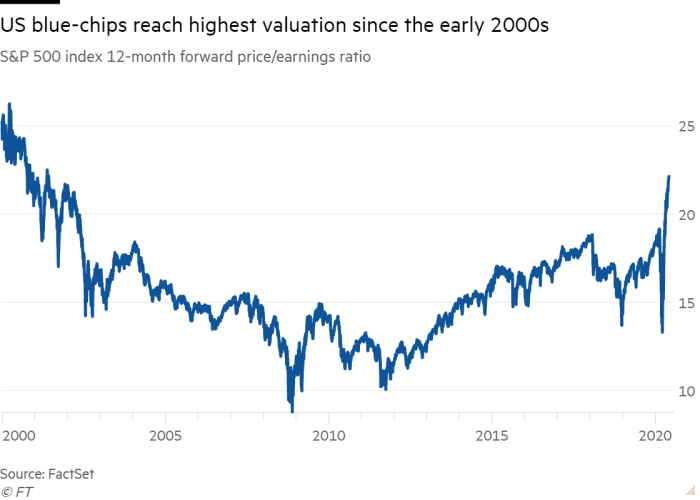Hedge funds braced for second stock market plunge

Simply sign up to the Hedge funds myFT Digest -- delivered directly to your inbox.
Hedge funds are getting ready for another slump in stock markets after growing uneasy that surging prices do not reflect the economic problems ahead.
Some managers fear that equity investors, used to buying the dips during the decade-long bull market that ended in March’s sharp sell-off, have become too complacent about how quickly economies can recover from the coronavirus crisis and how effective stimulus packages from central banks and governments can be.
The S&P 500 index completed its best 50-day run in history on Wednesday, according to LPL Financial, closing within 8 per cent of its record high of mid-February.
“The markets are priced to perfection,” said Danny Yong, founding partner at hedge fund Dymon Asia Capital in Singapore. “The stability in equity markets does not reflect the job losses and the insolvencies ahead of us globally.”
Mr Yong has been buying put options — which protect against market falls by allowing their owner to sell at a pre-determined price — on stock indices and also on currencies sensitive to risk appetite such as the Australian dollar and the Korean won.
“I believe we will see new lows in global equity markets later this year,” he added. “As March . . . has shown us, prices cannot diverge from fundamentals for too long.”
Other hedge fund managers have expressed concerns about the sharp rebound in stocks from the March lows.

Stanley Druckenmiller, a protégé of George Soros who stepped back from managing outside money a decade ago, recently said he expected a wave of bankruptcies and that a V-shaped economic recovery was a “fantasy”.
Paul Singer’s Elliott Management, which has $40bn in assets, wrote in its most recent letter to investors that since the impact of the economic downturn is greater than that of the 2008 financial crisis, “our gut tells us that a 50 per cent or deeper decline from the February top might be the ultimate path of global stock markets”.
The fund made money during the first-quarter crash from hedges in stocks and credit, and said it was trying to find new ways of protecting itself against another market fall after some hedges became more expensive.
Despite a slew of bleak economic data — including more than 40m Americans filing for unemployment benefits and an expected record contraction in the eurozone economy in the second quarter — the S&P 500 has surged almost 40 per cent since its trough in March, leaving it down just 3 per cent for the year. The index is now trading at more than 22 times expected earnings for the next 12 months, according to FactSet figures, taking the common valuation measure back to levels not seen since the early 2000s.

Mr Yong believes investors could soon discover that the so-called “Fed put” — the concept that the central bank will step in to support markets — may be reaching its limits.
“Some people believe the Fed’s unconventional measures are limitless but this is not the case,” he said. “It's now about the “Trump Put” — how much more stimulus can he push through? I think he [US president Donald Trump] will be constrained by Democrats in the House.”
Morgan Stanley said in a recent note that its hedge-fund clients hold a net short position of about $40bn in Euro Stoxx 50 futures. Global macro hedge funds have sharply reduced their exposures to stocks this year, according to JPMorgan Cazenove.
“It is entirely possible that there will be a fourth-quarter reckoning, where a second wave of job losses and a prolonged period of business failures tests equity sentiment,” said Seema Shah, chief strategist at Principal Global Investors.
Francesco Filia, head of London-based hedge fund Fasanara Capital, is holding 70 per cent of his fund in cash and also using put options and other instruments to hedge his portfolio while he waits for a “severe rupture” in markets.
He sees threats in the trend towards “deglobalisation,” which could drive inflation higher, and growing political interference in the technology sector, which could hurt shareholder returns. He expects a potential “2008-style . . . daily liquidity crisis” as investors try to pull money from exchange traded funds that may not be able to meet those redemptions.
However, many fund managers are reluctant to bet outright against stocks in the face of stimulus efforts from the Federal Reserve and European Central Bank, both of which have argued they have firepower in reserve.
The market hitting new lows “is possible”, said Tom Clarke, who has a low exposure to stocks at a macro fund at William Blair in London. But he added that government and central bank stimulus packages have “taken on almost mythical proportions. There’s no doubt in which direction policymakers want markets to go.”
Additional reporting by Adam Samson
laurence.fletcher@ft.com
Comments